Physical Address
304 North Cardinal St.
Dorchester Center, MA 02124
Physical Address
304 North Cardinal St.
Dorchester Center, MA 02124
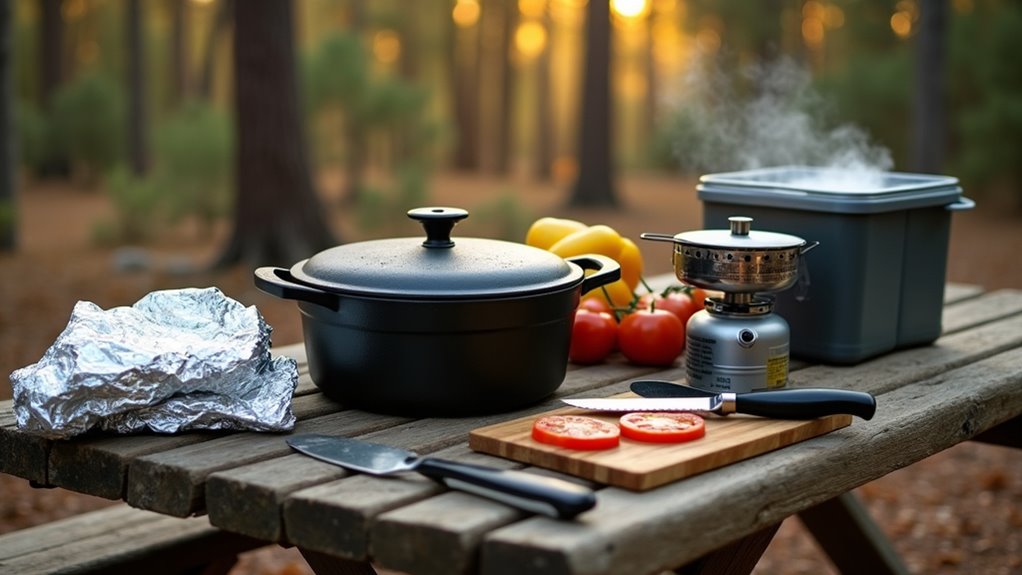
Master essential camping cooking techniques that transform basic outdoor meals into unforgettable wilderness feasts with these game-changing tips.
While your home kitchen offers endless conveniences, camping cooking strips you down to the bare essentials—and that’s where the real culinary adventure begins. You’ll discover that limited equipment doesn’t mean limited flavor when you master a few strategic techniques. From heat management over flickering flames to smart ingredient prep that saves precious time at your campsite, these practical approaches will transform your outdoor meals from mere sustenance into memorable experiences that’ll have you planning your next wilderness feast.
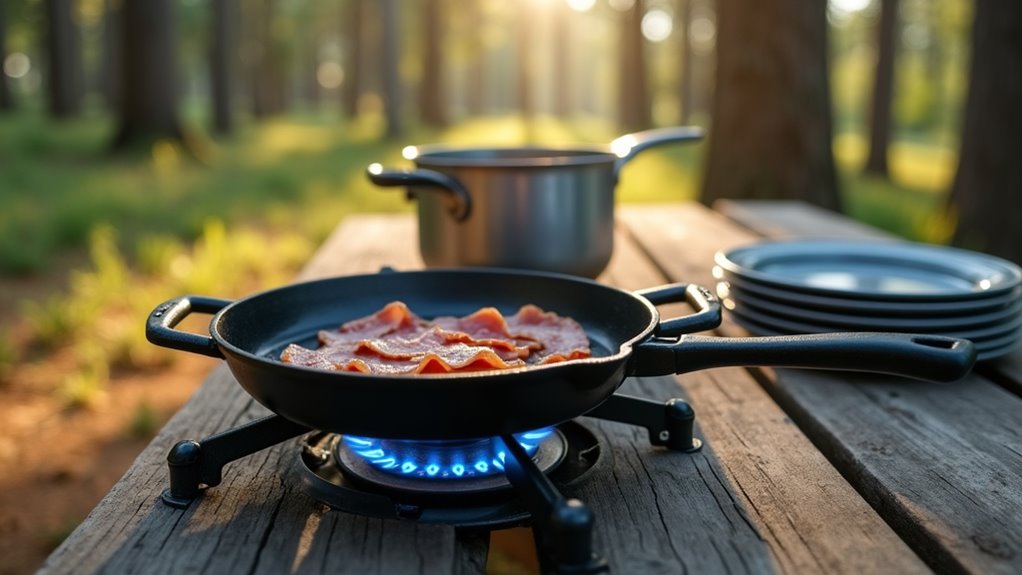
Before you start dreaming about gourmet trail meals, take inventory of what cooking gear you’re actually bringing. That single-burner camp stove won’t handle elaborate multi-course dinners, so stick to one-pot meals like pasta, chili, or stir-fries.
If you’ve got a portable grill, plan for burgers, hot dogs, or grilled vegetables. No refrigeration means focusing on shelf-stable ingredients and items that’ll keep in a cooler for your trip’s duration.
Match your menu to your skill level too. Camping isn’t the time to experiment with complex recipes you’ve never tried. Choose familiar dishes you can execute confidently, even when you’re tired after a long day hiking.
Pre-cut vegetables at home, pre-make spice mixes, and pack ingredients in meal-specific containers to streamline your cooking process. Having the right camping cookware setup will make meal preparation much more manageable in the outdoors.
One-pot meals become your best friend when you’re working with limited camp cooking equipment. They minimize cleanup while maximizing flavor and nutrition.
Start with hearty bases like pasta, rice, or quinoa, then layer in proteins and vegetables that cook at similar rates. Add faster-cooking ingredients like leafy greens or pre-cooked meats during the final minutes.
Master your liquid ratios—too little and you’ll burn the bottom, too much and you’ll get soup. Season generously throughout the cooking process, not just at the end.
Popular combinations include pasta with sausage and peppers, rice with beans and vegetables, or quinoa with chicken and broccoli. Keep stirring to prevent sticking, and don’t forget that residual heat continues cooking even after removing from flame.
One-pot cooking is also one of the most effective money-saving strategies for campers who want to stretch their food budget without sacrificing meal quality.

While you’re still in your well-equipped home kitchen, take advantage of sharp knives, cutting boards, and ample counter space to prep your camping meals. Chop vegetables, cube meat, and measure spices into labeled containers or zip-lock bags. You’ll save precious time at the campsite and eliminate the hassle of washing multiple utensils outdoors.
Pre-cut onions, bell peppers, and garlic for stir-fries or pasta dishes. Marinate proteins overnight in sealed bags – they’ll develop deeper flavors during transport. Portion out ingredients for each meal separately, creating grab-and-go packets that streamline cooking.
Don’t forget to prep non-perishables too. Mix dry seasonings, portion nuts and dried fruits, and pre-measure oil or vinegar into small containers. This preparation transforms chaotic camp cooking into organized, enjoyable meal creation. Having the right camping gear makes all the difference when it comes time to actually cook your pre-prepped ingredients at the campsite.
Since every ounce matters when you’re carrying gear to your campsite, choose cooking tools that serve multiple functions and maximize your meal-making potential. A cast iron skillet doubles as a griddle and serving plate. Pack a sharp knife that handles everything from chopping vegetables to cutting rope. Bring aluminum foil – it’s your makeshift grill grate, food wrapper, and cleanup tool rolled into one.
Consider a lightweight pot with a tight-fitting lid that transforms into a serving bowl. Silicone spatulas work as stirring spoons and scrapers. Don’t forget a can opener that includes a bottle opener and small knife blade. Wooden spoons won’t scratch your cookware and can handle high heat without melting like plastic alternatives.
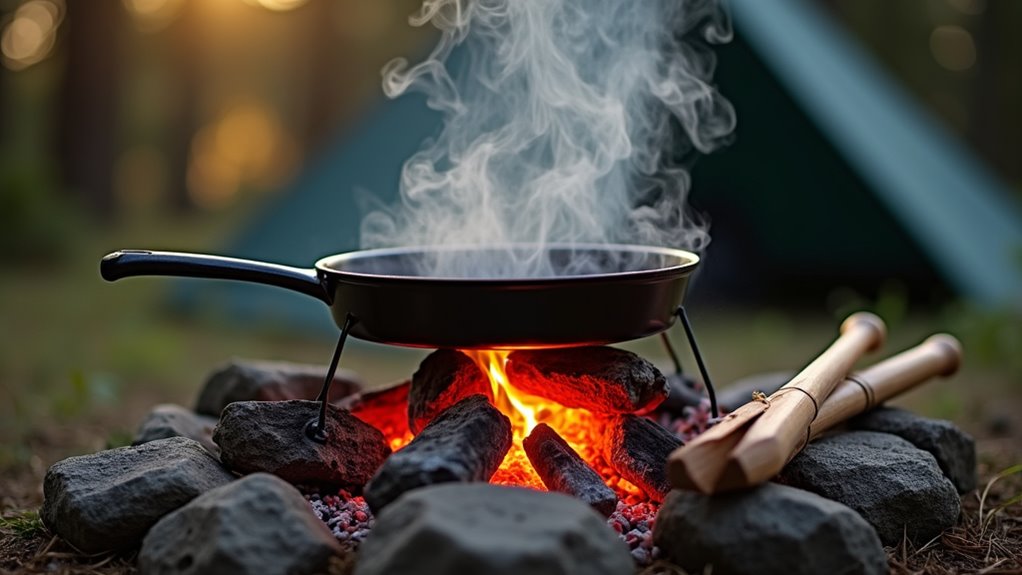
Managing your campfire’s heat requires constant attention because flames can quickly shift from perfect cooking temperature to food-scorching inferno. You’ll need to adjust your cooking grate’s height or move pots to cooler sections of the fire ring.
Campfire cooking demands vigilance—flames transform from ideal cooking heat to meal-destroying inferno in seconds without proper attention.
Create heat zones by pushing coals to one side for high heat while keeping the other side moderate for slower cooking.
Use the hand test to gauge temperature: hold your palm five inches above the coals. If you can keep it there for five seconds, that’s low heat; three seconds means medium; one second indicates high heat.
Keep extra kindling nearby for quick heat boosts, and always have water or dirt ready to control flare-ups that could ruin your meal.
Once your meal is finished and the fire dies down to a safe level, gather everyone around for some entertaining campfire games to cap off the evening.
Because campsite temperatures fluctuate dramatically and wildlife poses constant threats, you’ll need rock-solid food storage strategies that prevent both spoilage and unwanted animal encounters. Pack perishables in quality coolers with plenty of ice, keeping raw meats separated in sealed containers.
Store dry goods in airtight containers that critters can’t chew through.
Just as you’d research travel insurance before a vacation to protect against unexpected costs, planning your food storage strategy prevents costly camping disasters and ensures a safe outdoor experience.
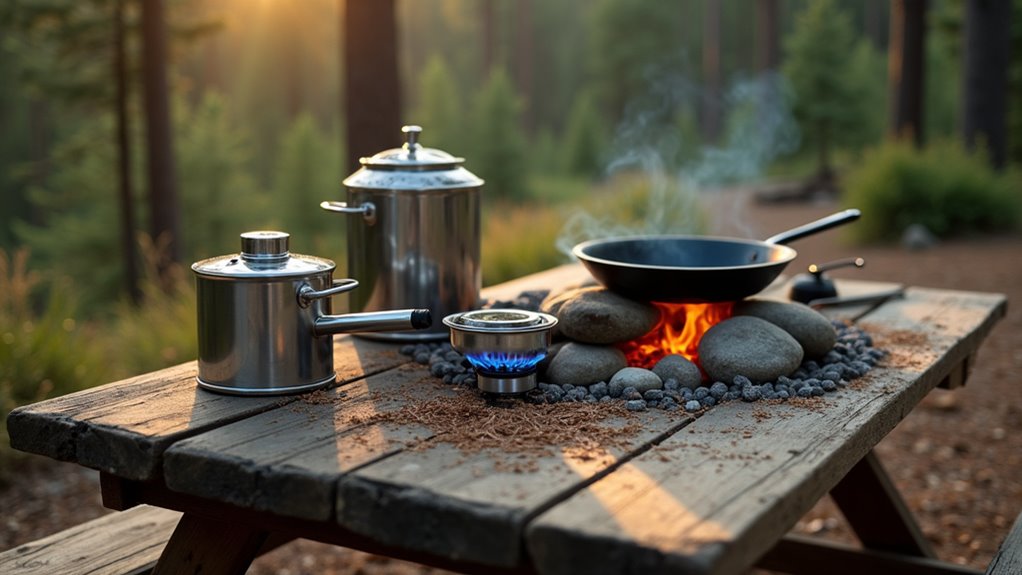
When your primary camp stove decides to quit working halfway through preparing dinner, you’ll be grateful for having alternative cooking methods ready to deploy. Pack a lightweight backup burner or portable grill as your secondary option.
Don’t overlook fire-based cooking – bring waterproof matches, a lighter, and fire starter cubes. A small folding grill grate transforms any campfire into a cooking surface.
Consider fuel-free alternatives like a solar cooker or thermal cooking bag for extended cooking without additional resources. Pack a manual can opener since electric versions won’t help you here.
Test all backup equipment before leaving home to ensure everything functions properly. Having multiple cooking methods prevents a equipment failure from ruining your meal plans and keeps everyone fed regardless of circumstances.
Just as you carefully research and select camping gear like tents based on specific requirements, your backup cooking equipment should match your camping style and expected conditions.
While you can’t bring your entire spice cabinet on a camping trip, you don’t have to settle for bland food either. Smart seasoning starts with versatile basics that pack maximum flavor punch. Salt and pepper are obvious essentials, but garlic powder, onion powder, and paprika transform simple ingredients into satisfying meals.
Pre-mixed seasonings like Italian herbs, taco seasoning, or curry powder eliminate guesswork and save precious packing space. You’ll create complex flavors without juggling multiple containers.
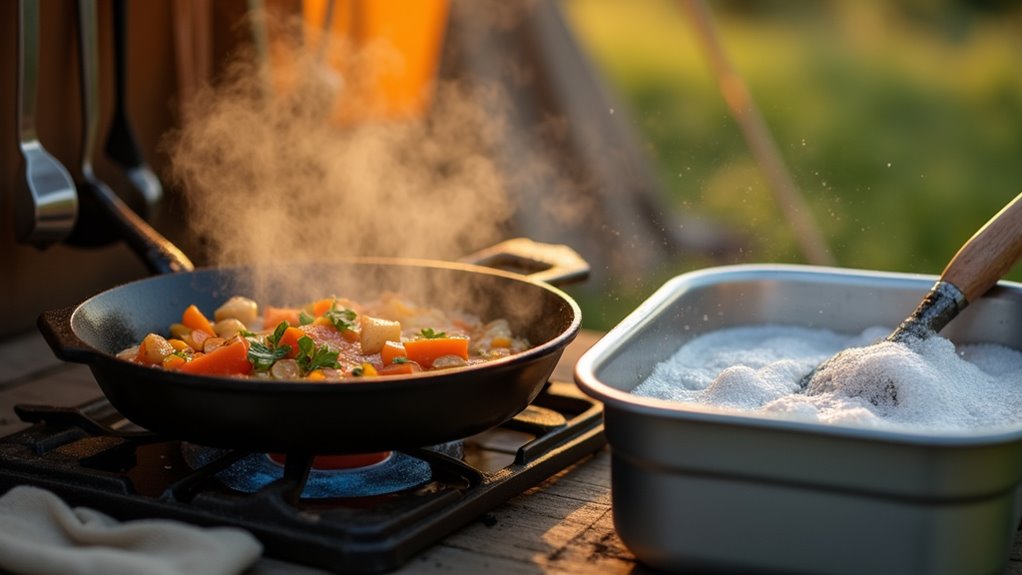
Since camping cleanup often becomes the least favorite part of any outdoor cooking adventure, developing a clean-as-you-go strategy will save you hours of scrubbing and frustration later. Start by filling a large pot with water and placing it on your camp stove as soon as you begin cooking. You’ll have hot water ready for washing throughout the meal preparation.
Wash utensils immediately after each use, and designate one person as the “cleaner” while others cook. Keep a damp cloth nearby to wipe surfaces constantly. Use paper plates and disposable cups when possible to reduce washing loads. Pack dirty dishes in a mesh bag to rinse together at water sources.
This systematic approach transforms cleanup from a dreaded chore into manageable mini-tasks. When camping as couples, you can make dishwashing more enjoyable by turning it into a team activity where one person washes while the other dries and puts items away.
Beyond keeping your cooking area tidy, you’ll need to prioritize safety when cooking over an open flame. Campfire cooking poses unique risks that require constant attention and preparation.
Always keep water or sand nearby to extinguish flames quickly if needed. Position your cooking grate securely over stable coals rather than active flames for better heat control. Never leave your fire unattended while cooking, even for a few minutes.
Essential campfire cooking safety measures:
Following proper campfire safety protocols will help ensure your outdoor cooking experience remains both enjoyable and secure.
You’ve got the blueprint for campfire cooking success. Don’t let your outdoor kitchen become a battlefield—these tips will keep you from sending smoke signals for takeout delivery. Remember, the key is preparation and practice. Start with simple one-pot meals, keep your tools versatile, and always prioritize safety. Master these fundamentals, and you’ll transform raw ingredients into memorable meals under the stars. Your fellow campers will wonder how you make it look so effortless.